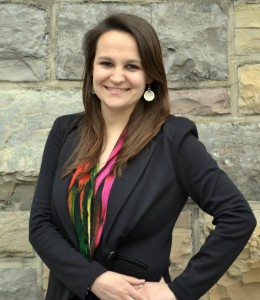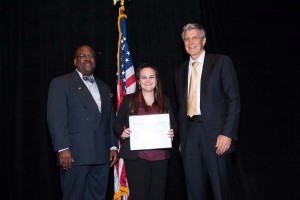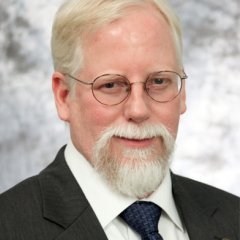

The final report for Human Factors Evaluation of an In-Vehicle Active Traffic and Demand Management (ATDM) System, submitted by Kayla Sykes, M.S., has been released.
This research study focused on the development and subsequent evaluation of an in-vehicle Active Traffic and Demand Management (ATDM) system deployed on Interstate 66 in Northern Virginia. The ATDM elements inside the vehicle allowed drivers to remain consistently aware of traffic conditions and roadway requirements even if external signage was inaccessible.
Forty participants were accompanied by a member of the research team and experienced the following in-vehicle device (IVD) features: 1) dynamic speed limits, 2) dynamic lane use/shoulder control, 3) High Occupancy Vehicle (HOV) restrictions, and 4) variable message signs (VMS). This ATDM system was equipped with auditory and visual alerts to notify the driver when relevant information was updated. The research questions addressed distraction, desirability, and driver behavior associated with the system. Participant data was collected from the instrumented vehicle, various surveys, and researcher observation.
Several key findings were uncovered related to each research category: 1) the IVD would not be classified as a distraction according to the National Highway Traffic Safety Association (NHTSA) distraction guidelines, 2) 73% of participants would want the in-vehicle technology in their next vehicle, and 3) the speed limit alert motivated participants to alter their speed (based on both survey results and actual participant speed data).
Click here to learn more about this project and read the final report.
 Kayla Sykes was honored at the Council of University Transportation Centers (CUTC) 2015 Annual Awards Banquet on January 9, 2016. For the past 24 years, the U.S. Department of Transportation (USDOT) has honored an outstanding student from each UTC at this special ceremony held during the Transportation Research Board (TRB) Annual Meeting. This year, students were recognized during the ceremony by the Assistant Secretary of Transportation for Research and Technology, Greg Winfree, and CUTC President, Joel Volinski. During the banquet, U.S. Secretary of Transportation Anthony Foxx gave the keynote address and Norman Mineta, former U.S. Secretary of Transportation, and Edd Hauser, director of the Center for Transportation Policy Studies at University of North Carolina-Charlotte, were honored with Lifetime Achievement Awards.
Kayla Sykes was honored at the Council of University Transportation Centers (CUTC) 2015 Annual Awards Banquet on January 9, 2016. For the past 24 years, the U.S. Department of Transportation (USDOT) has honored an outstanding student from each UTC at this special ceremony held during the Transportation Research Board (TRB) Annual Meeting. This year, students were recognized during the ceremony by the Assistant Secretary of Transportation for Research and Technology, Greg Winfree, and CUTC President, Joel Volinski. During the banquet, U.S. Secretary of Transportation Anthony Foxx gave the keynote address and Norman Mineta, former U.S. Secretary of Transportation, and Edd Hauser, director of the Center for Transportation Policy Studies at University of North Carolina-Charlotte, were honored with Lifetime Achievement Awards.

USDOT Assistant Secretary of Research and Technology Greg Winfree and Joel Volinski, President of the Council of University Transportation Centers, honored Kayla Sykes as the 2015 CVI-UTC Student of the Year, on Saturday, January 9, 2016, in Washington, DC. (Photos by Leslie E. Kossoff/LK Photos)
Kayla was selected for the 2015 Outstanding Student of the Year Award from the CVI-UTC for her outstanding academic performance and excellence in research. Kayla is a Graduate Research Assistant for the Virginia Tech Transportation Institute (VTTI). She completed her graduate coursework for her Master’s Degree in Civil Engineering from Virginia Tech in Fall 2015. Kayla has presented several posters related to her research with VTTI at both the Undergraduate Research Symposium and the Civil Engineering Research Day at Virginia Tech. Kayla also presented a poster regarding her CVI-UTC project and Master’s research at the 9th Annual UTC Spotlight Conference on Connected and Automated Vehicles on November 4, 2015.
Kayla’s Master’s thesis focuses on a human factors analysis of an in-vehicle Active Traffic and Demand Management (ATDM) system. She worked closely with VTTI employees to create an in-vehicle device that provides the following information to the driver: 1) dynamic speed limits, 2) dynamic lane use/shoulder control, 3) High Occupancy Vehicle (HOV) restrictions, and 4) other traveler information through variable message signs (VMS). The study’s research questions address driver distraction, desirability, and driver behavior while using the in-vehicle system in various traffic conditions. The results of this study will add to the body of knowledge for the effectiveness of in-vehicle signage and ATDM features.
Kayla has accepted employment with Toxcel following graduation and plans to continue to focus on improving transportation through human factors research and implementation.
Learn more about Kayla’s CVI-UTC project Human Factors Evaluation of an In-Vehicle Active Traffic and Demand Management (ATDM) System.
The final report for Next Generation Transit Signal Priority with Connected Vehicle Technology, submitted by Dr. Jia Hu, Dr. Young Jae-Lee, Dr. Byungkyu Brian Park, and Seyedehsan Dadvar has been released.
This project utilized connected vehicle (CV) technology allowing two-way communication among vehicles and infrastructure to develop a next-generation Transit Signal Priority (TSP) system that does not have to rely on conventional TSP sensors. The research team extended a previously proposed TSP system based on CV technology (TSPCV) to handle conflicting requests and to coordinate passage between intersections in a travel corridor. The proposed TSP mechanisms minimize installation and maintenance costs by eliminating the need for local agencies to perform a level of service (LOS) study and/or volume/capacity (v/c) ratio for potential TSP intersections before installation. Simulation-based evaluation results showed that, compared to conventional TSP mechanisms, the proposed TSP logic reduces bus delays between 5% and 48% (TSPCVM) and decreases the delay of a bus progressing along a corridor between 35% and 68% (TSPCV-C). The range of improvement corresponds to the four different v/c ratios tested, which were 0.5, 0.7, 0.9 and 1.0. In most cases, the proposed TSP logic caused no negative effects.
A field experiment conducted on the Connected Vehicle test bed on the Virginia Smart Road, located at the Virginia Tech Transportation Institute (VTTI) in Blacksburg, Virginia, validated the performance of the proposed TSPCV system. The TSPCV algorithm provided green traffic signal timing to buses with different arrival times with a 100% success rate. It also reduced delays for a bus with a speed of 45 mph and a traffic signal with a 90-second cycle length and 30 seconds of green time by as much as between 32% and 75%. Moreover, the field experiment showed that two Global Positioning System (GPS) devices (regular and differential) performed almost identically and, in an aggregate sense, the difference in their performance was not statistically significant. This finding facilitates the large-scale implementation of TSP, since regular GPS devices are much cheaper than differential GPS devices and operated just as well for TSPCV.
Click here to learn more about this project and read the final report.
The mission statement of the Connected Vehicle/Infrastructure University Transportation Center (CVI-UTC) is to conduct research that will advance surface transportation through the application of innovative research and using connected-vehicle and infrastructure technologies to improve safety, state of good repair, economic competitiveness, livable communities, and environmental sustainability.
 Dr. Thomas A. Dingus serves as the director for the CVI-UTC, as well as the director of the Virginia Tech Transportation Institute (VTTI) and the National Surface Transportation Safety Center for Excellence (NSTSCE). Prior to joining Virginia Tech, Dr. Dingus was founding director of the National Center for Transportation Technology at the University of Idaho and was an associate director of the Center for Computer-Aided Design at the University of Iowa. Dr. Dingus has more than 220 technical publications and has managed approximately $300 million in research funding to date ($130 million as principal investigator).
Dr. Thomas A. Dingus serves as the director for the CVI-UTC, as well as the director of the Virginia Tech Transportation Institute (VTTI) and the National Surface Transportation Safety Center for Excellence (NSTSCE). Prior to joining Virginia Tech, Dr. Dingus was founding director of the National Center for Transportation Technology at the University of Idaho and was an associate director of the Center for Computer-Aided Design at the University of Iowa. Dr. Dingus has more than 220 technical publications and has managed approximately $300 million in research funding to date ($130 million as principal investigator).
